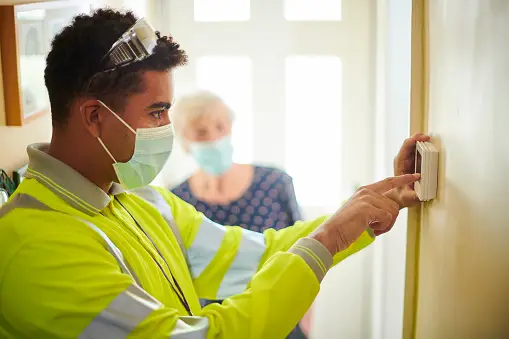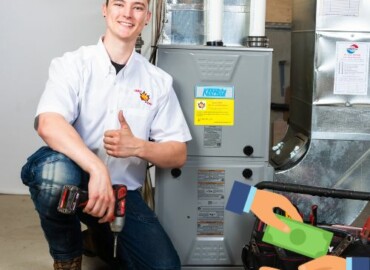When is the Right Time to Turn On Your Furnace?
As the temperature drops and the winter season approaches, it’s crucial to ensure that your home remains warm and comfortable. One of the most essential components of a cozy home during winter is a properly functioning furnace. However, turning on your furnace too early or too late can lead to discomfort or energy inefficiency. So, when is the right time to turn on your furnace?
Signs that indicate it’s time to turn on your furnace
- Chilly indoor temperatures: If you notice that your home is consistently colder than usual, it’s a clear sign that it’s time to turn on your furnace. While wearing a few extra layers may help temporarily, a well-functioning furnace is necessary to maintain a comfortable indoor environment. This typically happens when the outdoor temperature drops below the comfort range you’ve set for your home. A common indoor temperature setting is around 68-72 degrees Fahrenheit (20-22 degrees Celsius).
- Cold spots: If certain areas of your home feel significantly colder than others, it could be an indication that your furnace needs to be turned on. Cold spots can occur due to poor insulation or inadequate heat distribution, both of which can be alleviated by a working furnace.
- Increased humidity: When the weather becomes colder, the air tends to be drier. If you notice an increase in static electricity or dry skin, it’s a sign that your furnace should be turned on to help regulate indoor humidity levels.
Factors to consider when deciding to turn on your furnace
- Outdoor temperature: While there’s no fixed date to turn on your furnace, it’s often recommended to consider the outdoor temperature. If the temperature consistently drops below 60 degrees Fahrenheit (15 degrees Celsius), it’s a good time to start using your furnace.
- Personal comfort: Each individual has a different tolerance for cold temperatures. If you find yourself constantly shivering or feeling uncomfortable indoors, it’s a clear indication that it’s time to turn on your furnace.
- Energy costs: Energy consumption plays a significant role in determining when to turn on your furnace. If you’re concerned about energy bills, it may be wise to delay turning on your furnace until absolutely necessary. However, keep in mind that prolonged exposure to cold temperatures can result in higher heating costs when you finally do turn on your furnace.
Setting the right temperature for your furnace in winter?
Once you’ve made the decision to turn on your furnace, it’s important to set the right temperature to maintain a comfortable and energy-efficient home. Here are a few tips to help you find the optimal temperature:
- Consider personal preferences: Different individuals have different temperature preferences. Set your furnace at a temperature that ensures your comfort without being excessively warm.
- Energy-saving mode: Many modern furnaces come equipped with energy-saving modes or programmable thermostats. Utilize these features to set lower temperatures during periods when you’re away from home or sleeping.
- Experiment with temperatures: Don’t be afraid to experiment with different temperatures to find the right balance. Gradually adjust the temperature to determine what works best for you and your household.
Energy-saving tips for efficient furnace usage
While turning on your furnace is essential for a warm home during winter, it’s equally important to use it efficiently to minimize energy consumption and reduce utility bills. Here are some energy-saving tips:
- Proper insulation: Ensure that your home is properly insulated to prevent heat loss. Insulate windows and doors, seal gaps, and consider using weatherstripping to keep the warm air inside.
- Regular maintenance: Schedule regular maintenance for your furnace to ensure it operates at peak efficiency. Clean or replace air filters as recommended by the manufacturer to maintain optimal airflow.
- Utilize natural heat sources: Take advantage of natural heat sources during the day. Open curtains or blinds to allow sunlight in, and close them at night to retain the warmth.
Common furnace problems and troubleshooting
Sometimes, despite our best efforts, furnaces can encounter issues. Here are a few common furnace problems and some troubleshooting tips:
- No heat: If your furnace isn’t producing heat, ensure that the thermostat is set to the desired temperature. Check the circuit breaker to see if it’s tripped, and inspect the air filter for blockages.
- Inconsistent heating: If certain areas of your home aren’t receiving sufficient heat, it may be due to blocked vents or ductwork. Ensure that all vents are open and unobstructed, and consider having your ductwork inspected for any leaks or blockages.
- Unusual noises: Strange noises coming from your furnace can indicate various issues. Rattling noises may suggest loose components, while screeching sounds could indicate a faulty blower motor. If you’re unable to identify the source of the noise, it’s best to contact a professional technician for assistance.
Furnace maintenance checklist for optimal performance
Regular maintenance is crucial to keep your furnace running smoothly and efficiently. Here’s a checklist to help you maintain optimal furnace performance:
- Clean or replace filters: Dirty or clogged filters can impede airflow and reduce efficiency. Clean or replace your furnace filters as recommended by the manufacturer.
- Inspect and clean vents: Regularly inspect and clean vents to ensure proper airflow. Remove any dust or debris that may be blocking the vents.
- Check thermostat settings: Verify that your thermostat is functioning correctly and accurately reflects the desired temperature. Replace batteries if necessary.
- Inspect electrical connections: Ensure that all electrical connections are secure and free from corrosion. Loose or faulty connections can affect the performance of your furnace.
- Schedule professional maintenance: Consider scheduling an annual furnace maintenance appointment with a professional technician. They will perform a thorough inspection, clean internal components, and address any potential issues.
When to schedule a professional furnace inspection
While regular maintenance can significantly extend the lifespan of your furnace, it’s essential to schedule a professional inspection to identify any underlying issues. Here are a few instances when a professional inspection is recommended:
- Unusual odors: If you detect strange or unpleasant odors coming from your furnace, it could be a sign of a gas leak or other potentially hazardous issues. Contact a professional technician immediately for an inspection.
- Frequent cycling: If your furnace frequently turns on and off, it may indicate an underlying issue. A professional inspection can help identify the cause and prevent further damage.
- Aging furnace: If your furnace is more than 15 years old, it’s advisable to schedule a professional inspection to assess its condition and ensure it’s working optimally.
Alternative heating options to consider before turning on your furnace
While furnaces are the most common method of heating homes, there are alternative options to consider before turning on your furnace. These alternatives can help reduce energy consumption and provide additional comfort during winter. Here are a few options:
- Electric blankets: Electric blankets are a cost-effective way to stay warm without heating your entire home. They provide localized warmth and can be a cozy addition to your bed or favorite chair.
- Space heaters: Space heaters are portable devices that can provide targeted heat to specific areas of your home. They are particularly useful if you spend most of your time in one room and want to avoid heating the entire house.
- Fireplaces and wood-burning stoves: If you have a fireplace or a wood-burning stove, they can serve as an alternative heat source. However, ensure that they are well-maintained and used safely to prevent fire hazards.
Conclusion and final thoughts
Knowing when to turn on your furnace is crucial for a comfortable and energy-efficient winter season. Pay attention to the signs that indicate it’s time to start using your furnace, consider factors like outdoor temperature and personal comfort, and set the right temperature to maintain a cozy home. Remember to implement energy-saving tips and schedule regular maintenance to ensure optimal furnace performance. If you experience any issues or concerns, don’t hesitate to contact a professional technician for inspection and assistance. Stay warm and enjoy a cozy winter!
If you are looking for a furnace repair service in Toronto, Call us.




